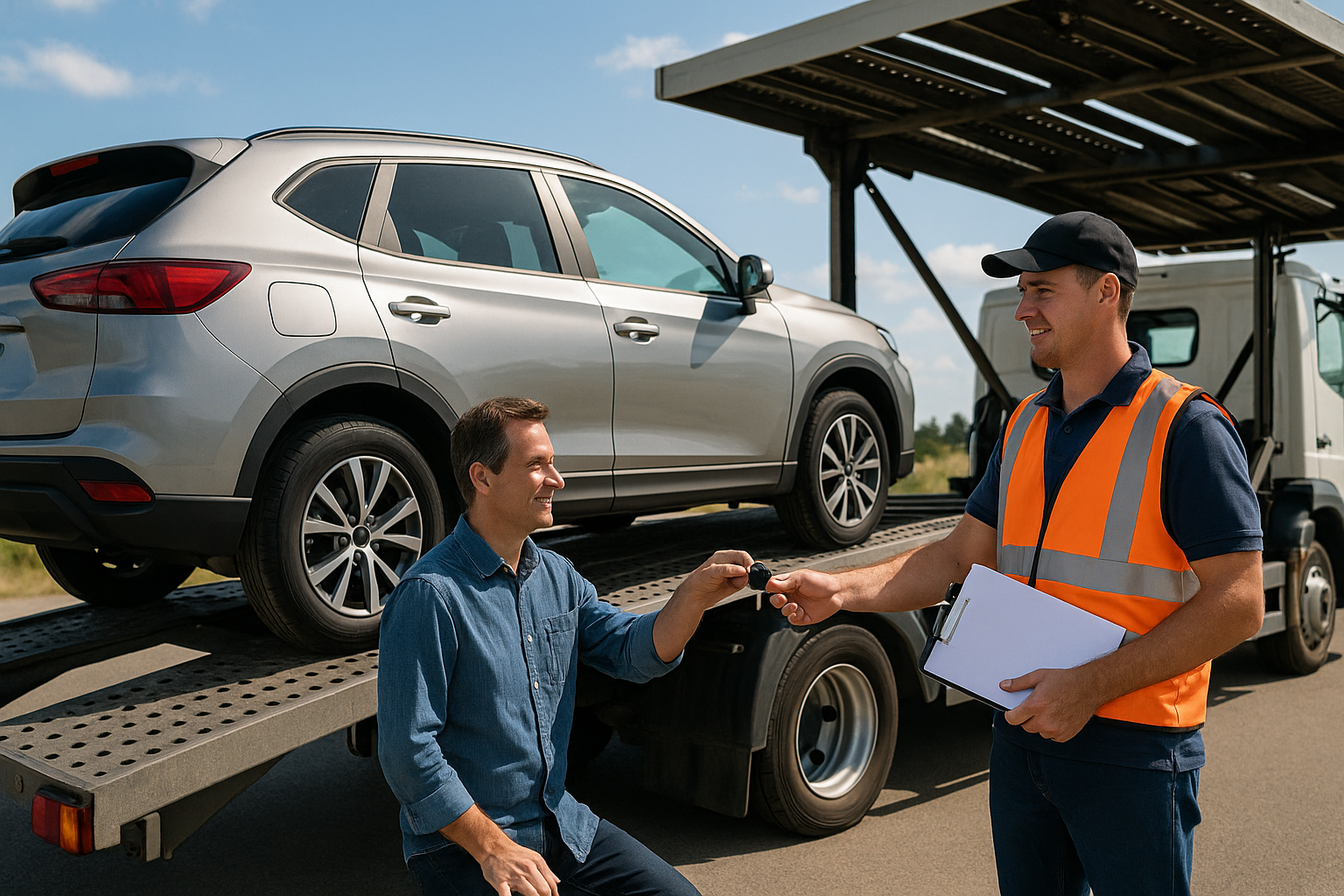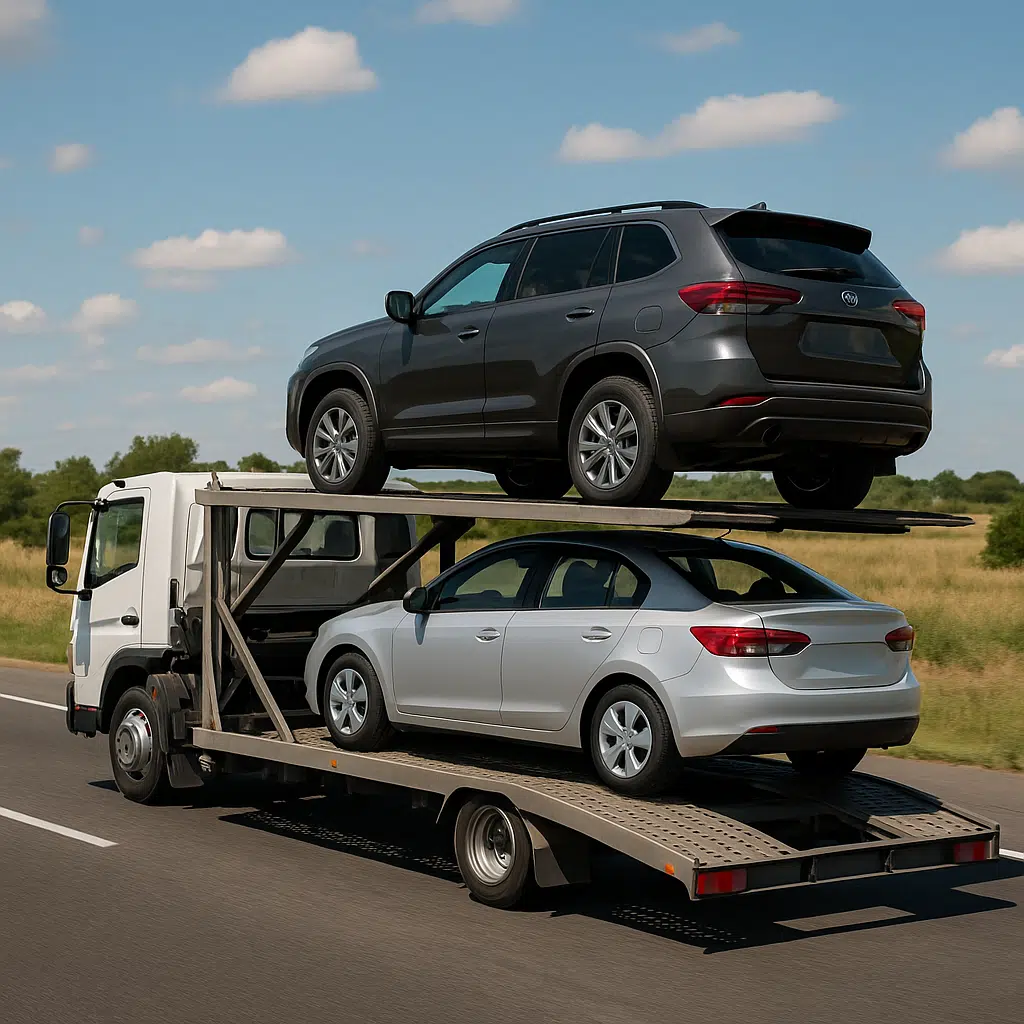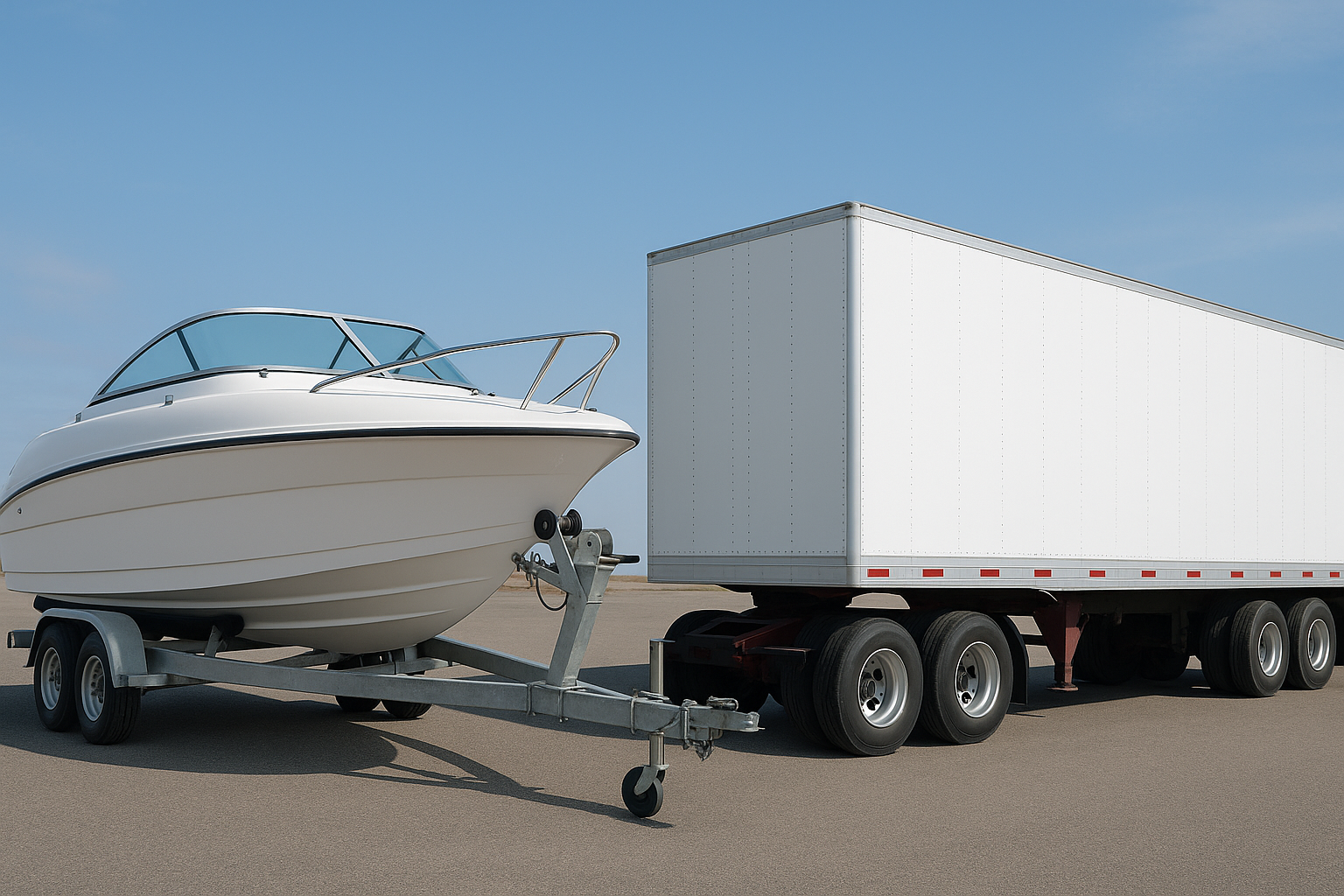What to Expect on Vehicle Pickup and Delivery Day
5–6 minutes read
Note: This is a general approach and each carrier and service company handle things differently.
Transporting a vehicle across Australia whether interstate or locally doesn’t have to be stressful. One of the easiest ways to ensure a smooth experience is to know exactly what to expect on pickup and delivery day. This guide walks you through every step, so you’re well prepared when the carrier arrives and when your vehicle is handed over.
1. Preparing for Vehicle Pickup
Before your car is collected, there are a few important things you’ll need to take care of. The transporter will perform a vehicle inspection, so it’s critical that the vehicle is clean. A clean car makes it easier to identify any pre-existing damage such as dents, scratches or chipped paint. Take time to remove all personal belongings from the vehicle, as most car carriers do not cover the contents during transit.
Check your vehicle’s fuel level, it should ideally be around one-quarter full. This provides just enough fuel for loading and unloading without adding unnecessary weight. Also check tyre pressure, battery health, and that your handbrake is functional.
Once ready, have your keys accessible and prepare any relevant paperwork. If someone else will be handing over the vehicle, let the transport company know in advance and ensure that person has written authority and ID if needed.
2. The Pickup Process
On the day of collection, the carrier will arrive within the pre-agreed time window. They will inspect the car with you (or your authorised contact), noting its condition in a Vehicle Condition Report (VCR). This report is crucial, as it forms the basis for any insurance claims in the event of damage during transit.
Photograph your vehicle from multiple angles before handing it over. Include close-ups of existing marks or damage and confirm that these are accurately listed in the VCR. If your vehicle is not in working condition, the driver will use special equipment to load it, be sure this has been communicated earlier to avoid delays or re-quotes. After completing the inspection and documentation, you or the nominated person will sign off on the condition report, and the carrier will load your car for transport.
3. During Transit
Once your vehicle is en route, National Car Movers’ trusted partners will keep it safe and secure. While in transit, your vehicle is covered by Transit Insurance or Carriers Liability Insurance, giving you peace of mind against unexpected events.
Some carriers offer GPS tracking or proactive SMS/email updates. If you’re unsure whether this is included in your booking, reach out to your assigned transport coordinator. In the event of route changes or delays, reputable providers will inform you in a timely manner and adjust delivery times accordingly. Transit durations vary depending on distance, weather, and road conditions, so staying flexible and informed is important.
4. Receiving Your Vehicle at Delivery
When your vehicle arrives at the destination, either you or a nominated person must be present to accept delivery. A second inspection will take place to compare the vehicle’s condition to the original pickup report. This step is essential to identify any new damage that may have occurred in transit.
Take the same care in inspecting your vehicle as you did at pickup, walk around it, check the bodywork, undercarriage, windows, lights, and tyres. Take fresh photos as proof of condition at delivery. If everything checks out, you’ll sign the VCR confirming receipt and condition of the vehicle.
If you notice any issues, document them clearly, raise them with the driver, and contact the transport provider immediately. Do not sign off as “received in good condition” until the matter is recorded and acknowledged.
5. What Happens If There’s a Delay?
While rare, delivery delays can happen due to weather, road closures, or carrier scheduling issues. In such cases, reputable companies like National Car Movers will keep you informed with revised ETAs and help manage any rescheduling.
Should a delay be more than 24–48 hours from the original delivery window, contact customer support to get a formal update and discuss next steps. Having realistic expectations and maintaining open communication can go a long way in reducing stress during unexpected delays.
Key Takeaways
- Clean and prep your vehicle before pickup and remove personal belongings.
- Be present for both inspections and take dated photos for insurance protection.
- Delays can happen, but professional carriers will keep you informed and supported.
- Transit insurance is included, but you should always verify coverage details in advance.
- National Car Movers provides end-to-end service with real support and clear communication.
Plan Ahead for a Smooth Experience
Knowing what to expect at both pickup and delivery helps reduce stress and makes the process seamless. By preparing your car, attending the inspections, and communicating with your transport provider, you increase the likelihood of a hassle-free experience.
National Car Movers works with fully licensed, insured, and experienced carriers who prioritise safety, communication, and customer care. We’re here to guide you through every step of your car transport journey across Australia.
Ready to Book a Worry-Free Car Transport Service?
Get a free instant quote now or speak with our friendly, Australian-based support team at 1300 396 099. Let us help you move your vehicle with confidence, no hidden costs, no guesswork, just trusted service.
Does Car Size Really Affect Transport Costs?
4–5 minutes read
Note: This is a general approach and each carrier and service company handle things differently.
When planning to move your vehicle interstate, one of the most common questions we hear is: does car size really affect transport costs? The short answer is yes and for good reason. From the amount of space a car occupies on a carrier to how it’s loaded and transported, vehicle dimensions directly impact pricing, logistics, and carrier availability. In this guide, we’ll unpack how vehicle size factors into transport costs and how you can make informed decisions when booking interstate car transport in Australia.
Why Size Matters in Car Transport
Vehicle carriers have a fixed amount of space available. Larger cars like SUVs, 4WDs, and vans take up more room than compact sedans or hatchbacks, meaning fewer vehicles can be loaded onto the same truck. This leads to fewer bookings per load and higher transport costs per vehicle for the carrier.
If your vehicle is oversized, modified, or unusually shaped (like a lifted 4WD or extended wheelbase van), the carrier may also need to make adjustments to loading procedures or equipment. These special handling requirements often come with additional fees.
Weight and Height Considerations
It’s not just length and width that affect transport fees, weight and height are also critical. Heavier vehicles may require reinforced trailers or be subject to road transport weight regulations, especially on interstate routes. Similarly, if your vehicle exceeds standard height restrictions, it may need to be transported on an open carrier with higher clearance or in a special enclosed truck, both of which cost more.
Looking to move a trailer, SUV, or ute? Our team can help with interstate car transport for larger vehicles.
Types of Vehicles That Typically Cost More to Transport
While every quote is tailored to the specific transport job, here’s a quick rundown of vehicles that usually incur higher transport costs:
- SUVs and 4WDs
- Dual-cab utes
- Vans and minibuses
- Classic or modified cars (due to special handling)
- Non-drivable or damaged vehicles (additional loading equipment required)
Need help moving a non-running or damaged car? Check out our detailed FAQ on how to move a non-running vehicle.
How to Get an Accurate Quote
To ensure you get an accurate and fair quote, be upfront about your vehicle’s dimensions, modifications, and condition. Accurate details allow our transport partners to allocate the right carrier, avoid loading issues, and prevent last-minute re-quotes or delays.
For example, when you request a quote with National Car Movers, we ask for your vehicle’s make, model, and condition to match you with the right transporter and provide the best available pricing, with no hidden costs.
Tips to Save on Larger Vehicle Transport
If you’re moving a larger vehicle and want to keep costs down, here are a few suggestions:
- Opt for depot-to-depot service instead of door-to-door; it’s often cheaper and suitable for flexible schedules.
- Book early, especially during peak seasons like the Christmas holidays.
- Remove roof racks or external fittings if possible, to reduce vehicle height.
- Ensure your vehicle is drivable, if possible, non-operational cars cost more due to loading complexity.
Want to understand other cost factors beyond car size? Check out our article on key factors that affect trailer transport costs.
Key Takeaways
- Yes, car size directly affects transport costs especially for larger vehicles like SUVs, utes, and vans.
- More size = more space = more cost due to carrier limitations and higher fuel usage.
- Providing accurate vehicle dimensions ensures a realistic quote and avoids costly surprises on pickup day.
Get a Quote Based on Your Vehicle Type
At National Car Movers, we handle everything from compact hatchbacks to lifted 4WDs, trailers, and more. With our network of fully insured Australian carriers, we’ll match you with the best transport option for your vehicle’s size and destination.
Get a fast quote today or call 1300 396 099 to speak to our local support team.
Boat Trailer vs Cargo Trailer Transport: Key Differences
4 min read
Note: This is a general approach and each carrier and service company handle things differently.
Transporting trailers interstate or over long distances across Australia requires a professional approach, but not all trailers are the same. Two of the most commonly moved types are boat trailers and cargo trailers, and while both fall under the umbrella of trailer transport, they have distinct differences in how they’re handled, what equipment is needed, and the regulations involved.
Whether you’re relocating, selling, or purchasing a trailer, understanding the key differences between boat trailer and cargo trailer transport will help you plan better, avoid delays, and ensure your trailer arrives safely and on time.
What Is a Boat Trailer?
A boat trailer is specifically designed to carry a boat. These trailers often feature adjustable supports, rollers, or bunks that cradle the hull. They’re typically longer and more open than standard trailers and may have a V-shape to accommodate the boat’s form.
Boat Trailer Transport Considerations:
- Non-standard dimensions: Boat trailers often exceed typical height or length limits, requiring special routing or an Oversize/Overmass (OSOM) permit.
- Towing vs. loading: Depending on roadworthiness and boat size, they may need to be winched onto a flatbed or transported with the boat secured onboard.
- Weather protection: Boats being moved on their trailers may need to be shrink-wrapped or covered to avoid wind, dust, and weather damage.
- Special care: Boats are high-value assets, so insurance coverage, handling experience, and proper tie-downs are essential.
Need help moving your boat? Visit our interstate boat transport service page for full details.
What Is a Cargo Trailer?
A cargo trailer (also called an enclosed trailer or box trailer) is an enclosed unit designed to carry goods, tools, or equipment. These trailers come in various sizes and are often towed behind utes or vans.
Cargo Trailer Transport Considerations:
- Enclosed design: This protects the contents during transit but also adds weight and height.
- Roadworthiness: As with all trailers, working brakes, lights, and tyres are essential for safe towing or loading.
- Loading flexibility: If the trailer is non-drivable, transporters may use tilt trays or flatbed trucks.
- Weight distribution: Heavily loaded cargo trailers must be declared properly to avoid issues during pickup and meet NHVR weight guidelines.
Looking to move your box or equipment trailer? Check out our interstate trailer transport services for tailored solutions.
Key Differences Between Boat and Cargo Trailer Transport
| Factor | Boat Trailer | Cargo Trailer |
| Shape & Dimensions | Often longer, with V-shape and open frame | Enclosed and rectangular, standard dimensions |
| Weight Considerations | May be lighter but longer; boat weight adds complexity | Enclosed structure may be heavier, especially when loaded |
| Loading Method | May be towed or winched, depending on roadworthiness | Often towed or lifted using flatbed or tilt trays |
| Protection Required | Requires additional weather protection | Already enclosed, contents usually protected |
| Permits Needed | OSOM permits often required | Permits less commonly needed unless oversized |
| Specialised Carriers | May need marine-specific carriers | General trailer carriers often sufficient |
How National Car Movers Handles Both Types
At National Car Movers, we partner with experienced, fully insured carriers who specialise in both boat and cargo trailer transport. Whether your trailer needs to be towed, winched, or lifted, our network can handle it with professional-grade equipment and attention to detail.
We provide:
- Transparent, no-obligation quotes
- Real-time updates on pickup and delivery
- Full support with permits and documentation
- Options for door-to-door or depot-to-depot delivery
Key Takeaways
- Boat trailers often require extra permits and protective measures due to their unique shape and cargo.
- Cargo trailers are easier to load and protect but can be heavier when fully packed.
- Choosing the right provider ensures you get the equipment, permits, and care required for your specific trailer type.
- National Car Movers makes trailer transport easy, safe, and compliant with all Australian transport laws.
Get a Fast Quote for Your Trailer Transport
Not sure which service suits your trailer? Let our team help. From recreational boat trailers to heavy-duty cargo units, we’ll match you with the right carrier for your needs — Australia-wide. Get an instant quote today or call 1300 396 099 to speak with our local experts.
How Long Does Car Transport Usually Take in Australia?
4 min read
Note: This is a general approach and each carrier and service company handle things differently.
Transporting your vehicle across Australia is a convenient and efficient solution for long-distance moves, dealership logistics, or online car purchases. However, one of the most common questions customers have is: How long will car transport actually take? The answer depends on several key factors including distance, route popularity, carrier availability, and the type of transport service selected. In this guide, we break down what to expect from the timeline, what may affect delays, and how to prepare for a smooth delivery.
Read moreHow to Transport Your Jet Ski Interstate Without Damage
4 min read
Note: This is a general approach and each carrier and service company handle things differently.
Moving your jet ski between states in Australia doesn’t need to be stressful, but it does require the right planning and precautions. Whether you’re relocating, heading to a seasonal destination, or selling your jet ski to a buyer interstate, ensuring it arrives safely and without damage is key. At National Car Movers, we specialise in coordinating safe, insured, and hassle-free transport for all types of vehicles, including jet skis. Here’s everything you need to know to move your personal watercraft with confidence.
Read more










